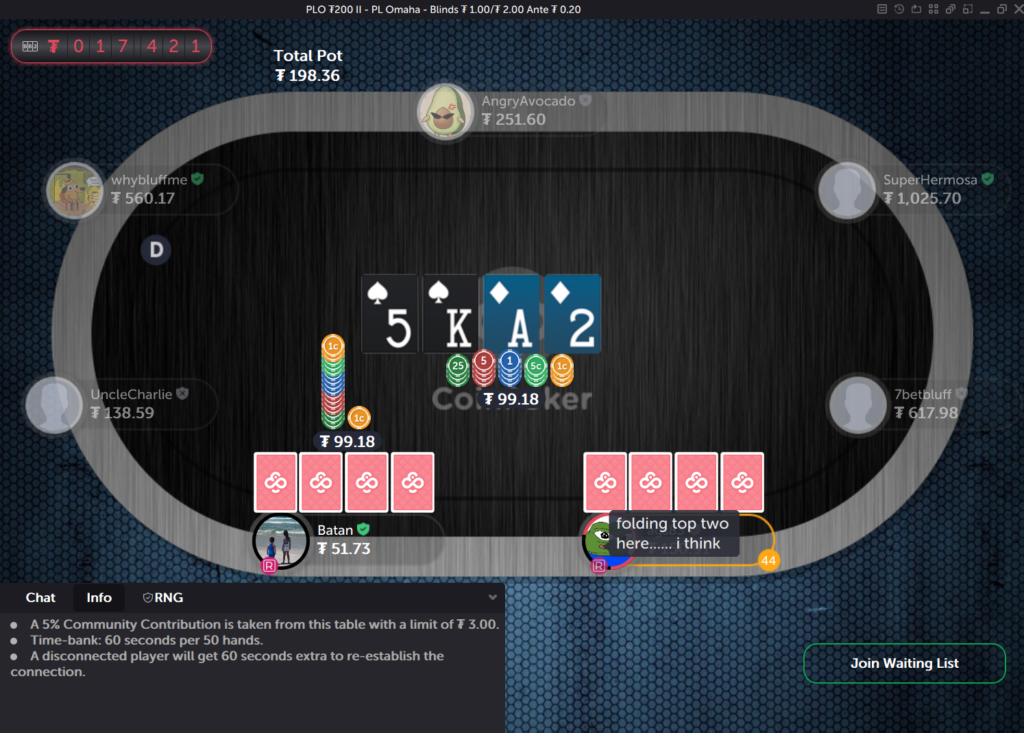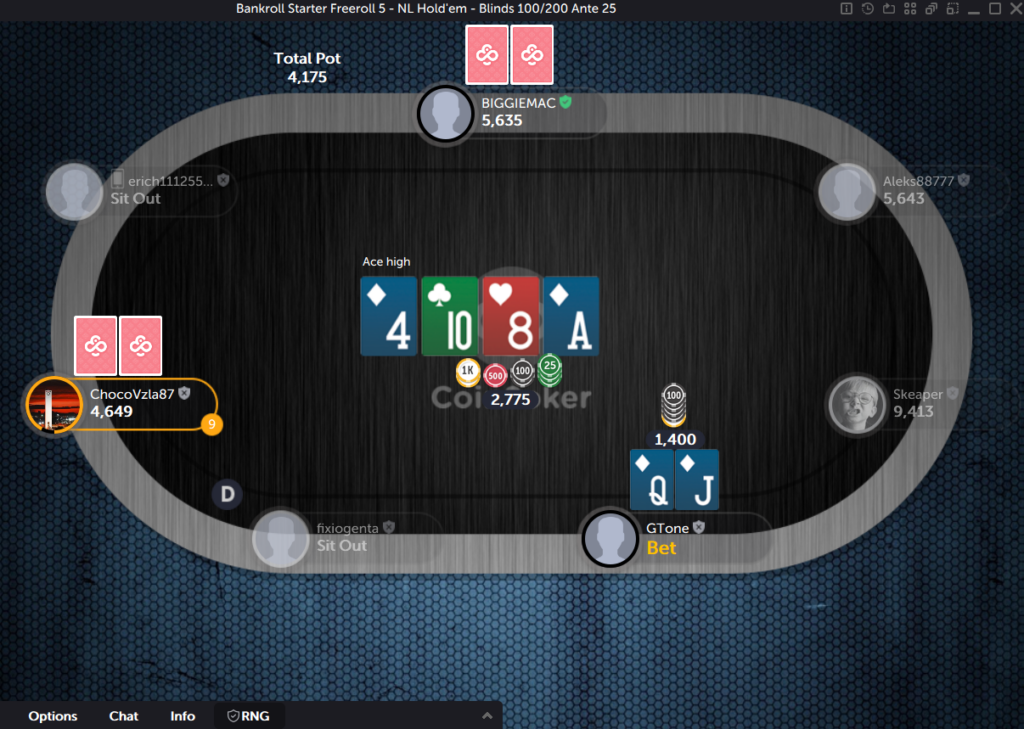Last Updated: 25 April 2025
Implied Odds Poker: Learn a New Approach to Pot Odds
The concept of implied odds poker teaches you to see valuable calls and consider future payoffs. Pick up this strategy by reading our essential guide.
StrategyBy using implied odds as part of your poker strategy, you can find new opportunities to make calls that seem unprofitable at first. With the implied odds formula, you will be able to calculate how much extra money you need to win on later streets in order to profitably call bets without enough equity.
In this article, we will teach you how to calculate implied odds, when to use them, and how they can help you profit more in your poker games.
What Are Implied Odds in Poker?
In the simplest of terms, implied odds represent the money or chips you stand to win on later betting streets if you improve your hand. Whenever you calculate your pot odds and equity, implied odds can come into play, especially if the equity you have is not high enough to make the call.
Whenever you face a bet or a raise, and your pot odds calculation tells you it is not a profitable call, you can start thinking about implied odds. If the stacks are deep and there is a lot of money left to play for, the call may still be profitable after accounting for implied odds.
Yet, it is important not to rely too much on implied odds or assume you will win all the money every time you improve your hand. Instead, a realistic comparison of your hand with your opponent’s hand range is needed, leading to a realistic implied odds calculation.

Simple Example of How Implied Odds Work
The best way to explain implied odds is through an example, so let’s take a look at a very simple one.
Imagine playing in a $2/$5 game with $1,000 left in your stack:
- With 9♠8♠ on the dealer button, you face an early position raise to $20.
- You call and the big blind calls as well.
- You go to a flop of K♣6♠5♦. The big blind bets $60 into the $62 pot and the original raiser folds.
The action is now on you, and you are facing a full-pot bet. The opponent is likely to have a strong hand like 66, 55, or 65, to be leading out into two opponents, which means your best chance to win the hand is to make your straight with one of the four 7 cards in the deck. However, with only four outs to a straight, you have only about 16% equity in the pot.
A quick pot odds calculation tells us you need about 33% equity to call a full pot bet, which means you should be folding. This is where implied odds kick in! While your current equity is not sufficient to call this bet, you stand to win a lot of money when you do make your straight. If your opponent does have a strong hand like 66 or 55, they will be hard-pressed to fold it when a 7 rolls off on the turn, making this call a lot more reasonable than it seems at first glance.
What Factors Affect Implied Odds?
Unlike pot odds, which are a mathematical constant, implied odds in poker are affected by various factors. Each of these factors can either increase or decrease the value of implied in a given hand. The three most important ones are:
- Position
- Board Runout
- Your Opponents
We’ll cover each of these main factors.
How Your Position Affects Implied Odds
Your table position relative to the other players still active in the hand can be of great importance when calculating implied odds. Being in position is usually vastly superior to being out of position in terms of the money you can win on later streets.
For example, if you are calling a turn bet and lack direct pot odds to make a call, the value of implied odds will be much greater if you have position. If you make your hand on the river in position, you will be able to either raise your opponent’s bet or bet if the opponent decides to check.
On the other hand, facing the same bet out of position, you will be forced to either lead out on the river (advertising you have improved your hand), or check and risk your opponent checking behind. This is why you should put a lot more value in implied odds when calling bets in position than out of position.
How Board Runouts Affect Implied Odds
The value of implied odds in poker is much higher on certain board runouts than on others. For example, if we hold Q♠T♠ on a board of A♦J♣6♠, we are drawing to a gutshot straight on a board that has no flush draws. In this case, making your hand can be hugely profitable, as it is difficult for your opponent to fold strong hands that are only beat by a single straight combination.
On the other hand, imagine considering calling a bet with A♦3♠ on a board of Kd♦T♦8♠9♦. In this case, you have the nut flush draw, but whenever you do make the flush on the river, there will be four diamonds on the board. This will make it a lot easier for your opponent to assume you have a flush, in which case they are likely to fold hands like sets, two pair, straights, or even weak flushes.
How Your Opponents Affect Implied Odds
The final factor to consider when calculating implied odds is your opponents. When facing bets from tight opponents who are likely to have a strong hand, the value of implied odds goes up, as such opponents are likely to call your future bets when you make your hand. The same goes for maniacs who are likely to keep bluffing into you when you improve, providing the extra value you need to make the call.
On the other hand, facing bets from opponents who think about the game on a deeper level and will be affected by board changes, implied odds will have less value. You should not expect to win every last cent of your opponent’s money if you make your flush when your opponent is a good player who knows what cards improve your range more than theirs.

How Do You Calculate Implied Odds?
In order to calculate your implied odds, you will need to build a formula made up of several components. The first two components you need are the pot size and the size of the bet you are facing, which are easily available. The final component of the formula is your equity. For this number, you will have to calculate equity according to the information you have at your disposal.
Once you have calculated your equity, you can use the following formula to calculate your implied odds:
[(1/EQ) * C] – (P + C)
Where EQ represents your equity, C represents the amount you need to call, and P represents the pot size after your opponent’s bet.
Finding Your Equity for Implied Odds Calculations
Before you can use the formula for poker implied odds we just introduced, you will need to calculate your equity. The equity calculation can be somewhat simple if you have a hand that has no showdown value and is simply drawing, and a bit more complex if you have a made hand.
If you are drawing to a straight or a flush, or even a pair for that matter, the first thing to do is count your outs. Outs are all cards that can improve your hand. Once you have counted the outs, you can use the “rule of 2 and 4” to quickly calculate your equity.
If you are facing a flop bet, multiply the number of outs by 4 to calculate your equity. If you are facing a turn bet, multiply your outs by 2. For example, if you have 9 outs (a flush draw), you would have 36% equity on the flop and 18% equity on the turn (approximately).
In some cases, the calculation can become a bit murky, as some outs might not be completely clean. For example, an overcard can potentially give you three outs to make top pair. However, that top pair won’t necessarily be the best hand if you do make it, which is why it’s very important to have a good idea of what hands your opponent’s range is made up of.
How to Use Implied Odds in Your Game
Now that you know the formula for calculating implied odds in poker and how to calculate your equity, it’s time to put that knowledge to use. Let’s take a look at a couple of examples and see how our implied odds calculations can help us in-game.
Using Implied Odds Facing a Bet
In a $1/$2 cash game, you face a $30 bet into a $30 pot on the turn. You hold K♦4♦ on a board of A♦7♦3♠9♥.
There are nine diamonds left in the deck, and you assume that each of them will give you the best hand. This means you have approximately 18% equity in this hand. A quick look at the pot odds chart says you would need 33% equity to make this call. Since you don’t have enough equity, let’s take a look at what the implied odds say.
We will fill out our formula with the following:
EQ = 0.18 (our equity in decimal form)
C = 30 (the amount we need to call)
P = 60 (pot size)
IO = [(1/0.18) * 30] – (60 + 30)
IO = (5.55 * 30) – 90
IO = 166.66 – 90
IO = 76.66
The result of 76.66 represents the dollar value you need to win on the river in order to make calling the turn bet profitable. Whenever you do improve into a flush, you would need to get your opponent to put an additional $76.66 or more into the pot in order to call profitably.
Once you reach this step, you will have to decide if your opponent’s range is strong enough for that to be true or not. If not, turning your hand into a bluff could be a better idea, as you may be able to force your opponent to fold a good chunk of his relatively weak range with a turn raise.
Using Implied Odds Facing a Raise
In a $1/2 cash game, you bet $20 into a $20 pot holding K♦4♦ on the same board of A♦7♦3♠9♥. Your opponent raises to $120, and the action is back on you.
Once again, you have 9 outs and approximately 18% equity in the hand, assuming your opponent is only raising value hands. You need to call $100 to win a pot of $260, meaning you would need to have approximately 28% equity for the call to be profitable.
Since you don’t have that much equity, you should once again consider implied odds. Let’s fill out the formula!
EQ = 0.18
C = 100
P = 160
IO = [(1/0.18) * 100] – (160 + 100)
IO = (5.55 * 100) – 260
IO = 555 – 260
IO = 295
This time around, you would need to win an additional $295 when you make your flush on the river in order to make calling the raise profitable. Assuming your opponent is only raising the turn with strong hands, they may be willing to call a big river bet. However, a $295 bet would be an overbet to the pot size and will probably not get called every time. In this particular case, it is unlikely you have enough implied odds to continue, suggesting a fold might be in order against this raise size.
What Are Reverse Implied Odds in Poker
Much like implied odds can turn an unprofitable call into a profitable one, reverse implied odds can do the opposite. Reverse implied odds come into play when there is a chance for turn and river cards to come that will often cause us to lose additional money.
While there is no simple reverse implied odds formula to rely on, the general rule of thumb is quite simple. When you are considering calling with close equity, think about the impact of reverse implied odds. Are your outs clean or will they often cause you to lose a huge pot or win a small one?
The best way to explain reverse implied odds is with an example, so let’s take a look at one.
Example of Reverse Implied Odds
Playing a $1/$2 cash game, you are in position against one opponent holding 8♠7♠. With $20 in the pot, your opponent bets $15 on a board of K♦9♥6♥. You hold an open-ended straight draw and may be thinking you have eight clean outs to your straight, giving you approximately 32% equity.
However, in this spot, it is worth considering the fact the T♥ and 5♥ are not clean outs. If you make your straight with these two cards, your opponent could have a flush on the turn or, at the very least, gain additional equity with a flush draw. While this does not mean you should necessarily fold right away, the reverse implied odds of the dirty outs should be taken into account.
If you face another bet on the turn, especially if that turn is any heart, you should very strongly consider folding your hands. Despite the fact you can make a straight, the reverse implied odds are working against you, in addition to the limited equity you have in the hand in the first place.
Place to Practice Using Implied Odds
Now that you have learned how to calculate and apply implied odds in-game, it’s time to start practicing. CoinPoker offers a variety of options for this, including the freeroll poker tournaments you can play without any risk and low-stakes cash games you can access with a minimal deposit and exposure.
Sign up with CoinPoker today to access a wide selection of poker tables across different games and stakes and practice your skills using pot odds, implied odds, and reverse implied odds against real opponents.
FAQs
Implied odds represent the amount of extra money you have to win on later betting streets to make a call profitable.
You can calculate implied odds using the formula IO = [(1/EQ) * C] – (P + C).
You can calculate your equity by counting out your outs and multiplying their number by 4 on the flop or 2 on the turn.
Implied odds are useful anytime you face a bet or raise where you don’t have enough equity to make a call directly profitable.
Reverse odds refer to the amount of money you stand to lose if certain cards come on the turn or river to improve your hand but give your opponent an even stronger one.
Explore More
Announcements
Read recent announcements from CoinPoker about new games, ambassadors, and changes to our platform.
8 PostsGuides
The go-to resource for mastering poker with expert tips and strategies. Whether you're a beginner or a pro, our guides will elevate your skill level.
52 PostsNews
Find the latest poker news from CoinPoker, plus our latest CoinPoker Weekly and Monthly Newsletters. Updates about games, promotions and other exciting crypto news.
82 PostsPromotions
Find the latest coinpoker promotions here. Explore the crypto poker world with the best poker promotions available.
1 Post















